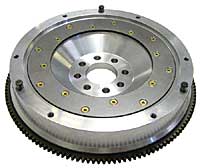
If you are considering changing the clutch and your budget will tolerate the added cost, you may also wish to change the flywheel at the same time.
The flywheel on an automobile engine is a large disc at the rear of the engine that has a great deal to do with how smooth the engine runs. It is fastened to the end of the crankshaft, the shaft that is rotated as the pistons go up and down inside the cylinders. The momentum of the flywheel is used in order to smooth out the operation of the engine as its speed changes.
As the engine builds up speed, part of its energy is used to spin the flywheel, which being large and heavy, requires some time to build up momentum. Once the flywheel is spinning, that momentum keeps it spinning for a short time, even after you let off on the gas and the engine is no longer producing as much power. The flywheel keeps the engine from speeding up or slowing down too abruptly, which in turn smooths out the car’s changes in speed, keeping your passengers more comfortable.
On most brands of automobile, the flywheel consists of a single metal disc with a center hub that clamps to the crankshaft. It also has a toothed gear around the outside edge against which the starter gears engage when you press the starter button.
For smoother performance in engine and clutch operation on the MINI Cooper S, BMW engineers have taken the basic flywheel design one step further. The MCS flywheel is what is known as a “dual-mass” flywheel. Instead of using just one disc, this flywheel consists of two discs with a spring mechanism in between. The spring mechanism allows the disc fastened to the crankshaft to rotate as much as 70 degrees, almost a quarter of a turn, before the disc that engages the clutch is put into motion.
This design permits smoother clutch engagement, and also damps out much of the noise and vibration that is generated between the clutch and flywheel. Here again, the designers have balanced comfort against performance, giving up a little performance to get a little comfort, which the average driver and passenger wants.
However, if you want to push the balance a little towards performance, and are willing to live with a bit more noise, especially when the car is not in gear, you can replace the stock flywheel with a lightweight single-disc flywheel. An aftermarket aluminum flywheel can weigh less than half the weight of the stock flywheel without risking engine longevity.
With a lighter flywheel, you’ll get quicker acceleration and deceleration. These are two positive benefits if you’re trying to get around an autocross course or track as quickly as possible, since best time of day will go the the car that can speed up on the straightaways faster, and slow down into the turns more quickly.
Since it seems as if every drivetrain modification in the typical tuner catalog promises increased horsepower, we should probably make sure that you understand that lightening the flywheel does not increase horsepower, since it doesn’t alter the engine operation. It simply increases the responsiveness of the car when you get on and off the throttle. Many drivers will mistake this responsiveness for added horsepower. The lightened flywheel will help reduce your lap times, and make driving more fun, but it won’t increase horsepower, grow hair on that bald spot, or perform any similar miracles.
A lightweight aluminum flywheel will cost approximately $500. Since it is necessary to remove the clutch to replace the flywheel, if you’re already substituting a high-performance clutch, it is considerably less expensive in the long run to change the flywheel at the same time.








1 comment:
good tip. i changed my flywheel and i noticed a HUGE diff in my 07 cooper s. Highly recomend.
Post a Comment